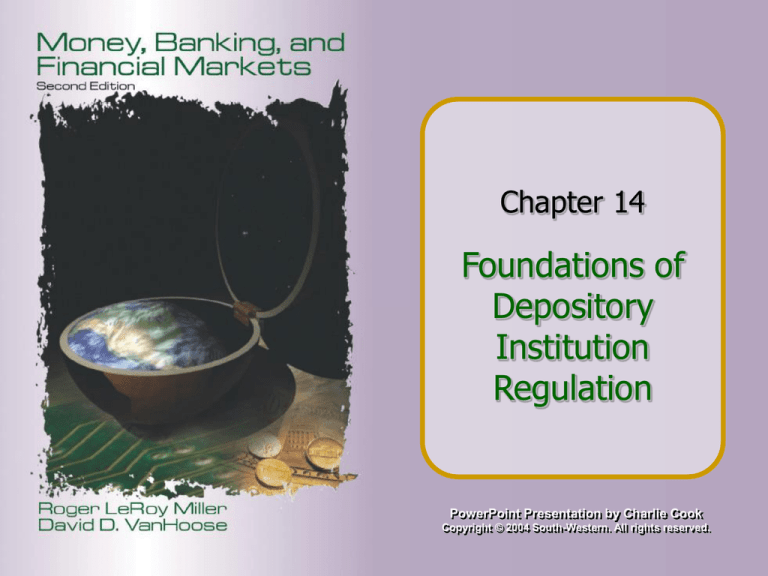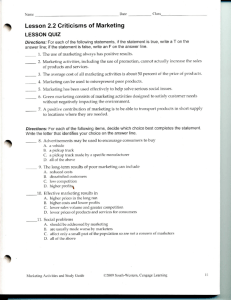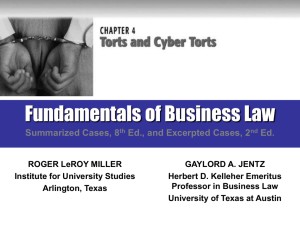
Chapter 14
Foundations of
Depository
Institution
Regulation
PowerPoint Presentation by Charlie Cook
Copyright © 2004 South-Western. All rights reserved.
Fundamental Issues
1. In what ways did laws adopted in the 1930s
exert long-term effects on the U.S. banking
industry?
2. How did deposit interest rate ceilings
ultimately help to spur depository institution
deregulation in the 1980s?
3. Why does the provision of federal deposit
insurance help to justify federal regulation
of depository institutions?
4. How has the federal government sought to
reduce the FDIC’s exposure to losses?
Copyright © 2004 South-Western. All rights reserved.
14–2
Fundamental Issues (cont’d)
5. How did the Financial Services
Modernization Act of 1999 alter the structure
of U.S.bank regulation and supervision?
6. Do national bank regulators coordinate their
policies?
Copyright © 2004 South-Western. All rights reserved.
14–3
Traditional Rationales for Government
Regulation of Depository Financial
Institutions
• Maintaining depository institution liquidity.
• Assuring bank solvency by limiting failures.
• Promoting an efficient financial system.
• Protecting consumers.
Copyright © 2004 South-Western. All rights reserved.
14–4
Federal Regulation: 1933–1970
• The McFadden Act of 1927
Restricted nationally chartered banks to branching
only according to state laws.
• The Banking Act of 1933 (Glass-Steagall Act):
Created the Federal Deposit Insurance Corporation
(FDIC), a guaranteed deposit insurance system for
commercial banks and savings institutions.
Separated commercial and investment banking.
Placed interest rate ceilings on checking deposits
of commercial banks.
Copyright © 2004 South-Western. All rights reserved.
14–5
Glass-Steagall Branching Restrictions
• Interstate branching:
The operation of banking offices in more than one
state was made illegal.
• Intrastate branching:
The operation of banking offices anywhere within a
state was left to the discretion of the states.
Copyright © 2004 South-Western. All rights reserved.
14–6
Partial Deregulation:1971–1989
• Disintermediation:
A situation in which customers of depository
institutions withdraw funds from their deposit
accounts and use these funds to purchase financial
instruments directly.
• Depository Institutions Deregulation and
Monetary Control Act (DIDMCA):
Set up a six-year phaseout of interest rate ceilings.
Permitted negotiable-order-of-withdrawal (NOW)
accounts (interest-bearing checking deposits).
Increased FDIC coverage to $100,000 per account.
Copyright © 2004 South-Western. All rights reserved.
14–7
Partial Deregulation:1971–1989
• The Garn–St. Germain Act of 1982:
Authorized money market deposit accounts.
Increase the DIDMCA limit on consumer loans and
commercial paper.
Authorized savings institutions to make commercial
real estate loans.
Gave these institutions the power to purchase
“unsecured loans,” including low-rated, “junk”
bonds.
Gave the FDIC power to permit troubled financial
institutions to merge with healthier partners.
Copyright © 2004 South-Western. All rights reserved.
14–8
Deposit Insurance Complications
• The moral-hazard problem of deposit
insurance:
The existence of federal deposit insurance can
lead depository institution managers to make riskier
choices than they might otherwise.
• Too-big-to-fail policy:
A regulatory policy that protects the largest
depository institutions from failure solely because
regulators believe that such failure could
undermine the public’s confidence in the financial
system.
Copyright © 2004 South-Western. All rights reserved.
14–9
Reregulation in the Late 1980s and Early
1990s
• Financial Institutions Reform, Recovery, and
Enforcement Act (FIRREA) 1989:
Created the Office of Thrift Supervision (OTS) and
the Federal Housing Finance Board.
Bank Insurance Fund (BIF):
FDIC fund covering insured deposits of commercial
banks.
Savings Association Insurance Fund (SAIF):
FDIC fund covering insured deposits of savings
institutions.
Copyright © 2004 South-Western. All rights reserved.
14–10
The FDIC Improvement Act Of 1991
• Structured early intervention and resolution
(SEIR):
A regulatory system that authorizes the FDIC to
intervene quickly in the management of a
depository institution that currently threatens to
cause losses for the federal deposit insurance
funds.
Copyright © 2004 South-Western. All rights reserved.
14–11
The FDIC Improvement Act Of 1991
• Deposit insurance premium:
The price that depository institutions pay to the
FDIC’s insurance fund in exchange for a guarantee
of federal insurance of covered deposits that they
issue.
• Risk-based deposit insurance premiums:
Premiums that depository institutions pay the FDIC
based on the varying degrees to which they are
capitalized and on the differing risk factors that they
exhibit.
Copyright © 2004 South-Western. All rights reserved.
14–12
Capital Requirements
• Capital requirements:
Minimum equity capital standards that regulators
impose upon depository institutions.
• Risk-based capital requirements:
Regulatory capital standards that account for risk
factors that distinguish different depository
institutions.
• Risk-adjusted assets:
A weighted average of bank assets that regulators
compute to account for risk differences across
types of assets.
Copyright © 2004 South-Western. All rights reserved.
14–13
Basel Capital Standards
• Core capital:
Defined by current capital requirements as
shareholders’ equity plus retained earnings.
• Total capital:
Under currently imposed bank capital
requirements, the sum of core capital and
supplementary capital.
• Supplementary capital:
Under standards currently used to calculate
required capital, a measure that includes certain
preferred stock and most subordinated debt.
Copyright © 2004 South-Western. All rights reserved.
14–14
The Effects of Capital Requirements
• A number of banks failed to meet the three
ratio requirements.
• Reduced issuance of loans in response to
higher capital standards.
Copyright © 2004 South-Western. All rights reserved.
14–15
Predicted Loan
Rate Effects of the
Imposition of Capital
Requirements
Figure 14–1a
Copyright © 2004 South-Western. All rights reserved.
14–16
Actual Loan Rate
Effects of the
Imposition of Capital
Requirements
Figure 14–1b
Copyright © 2004 South-Western. All rights reserved.
14–17
Equity as a Percentage of Bank
Assets in the United States,
1840–Present
SOURCE: SOURCES: Allen N.Berger, Richard J.Herring, and Giorgio
P.Szego, “The Role of Capital in Financial Institutions,” Journal of Banking
and Finance 19 (June 1995); and Federal Deposit Insurance Corporation.
Copyright © 2004 South-Western. All rights reserved.
Figure 14–2
14–18
The Financial Services Modernization
Act of 1999 (Gramm-Leach-Bliley Act)
• Act removes Glass-Steagall restrictions and
permits:
Securities firms and insurance companies to own
commercial banks.
Banks to underwrite insurance and securities,
including shares of stock.
Copyright © 2004 South-Western. All rights reserved.
14–19
The Ten Largest U.S.Banking Institutions
These were the ten top banking
companies as of 2002.
Citigroup, Inc.
J.P.Morgan Chase
Bank of America
Wachovia
Wells Fargo & Co.
Bank One
Metlife,Inc.
Taunus
Washington Mutual
FleetBoston
Assets ($ Billions)
$1,051
694
622
330
308
269
257
227
208
204
Table 14–1
Copyright © 2004 South-Western. All rights reserved.
14–20
International Linkages and Bank
Regulation
• Regulatory arbitrage:
The act of trying to avoid regulations imposed by
banking authorities in one’s home country by
moving offices and funds to countries with less
constraining regulations.
Copyright © 2004 South-Western. All rights reserved.
14–21
FDIC’s Most Costly Failure Resolutions since 1980
Depository
Institution
Assets
($ Billions)
Failure
Date
Resolution
Cost
($ Billions)
$33.5
15.7
33.6
4.8
July 1988
February 1989
May 1984
July 1989
$3.9
2.8
1.1
1.1
4.8
April 1988
21.8
January 1991
8.7
May 1988
3.4
March 1982
1.1 September 1999
1.1
0.9
0.8
0.8
0.8
First Republic Bank (Dallas)
MCorp (Dallas)
Continental Illinois (Chicago)
Texas American (Fort Worth)
First City Bancorp (Houston)
Bank of New England (Boston)
Goldome FSB (Buffalo)
New York Bank for Savings (NYC)
1st National Bank of Keystone (WV)
Crossland Savings Bank (Brooklyn)
Superior Bank (Illinois)
7.3
2.3
January 1992
July 2001
0.7
0.6
Table 14–2
Copyright © 2004 South-Western. All rights reserved.
14–22
FDIC Risk-Based Deposit Insurance Premiums,
1993 versus Today
(a) January 1,1993
Risk Classification
Well Capitalized
Adequately Capitalized
Undercapitalized
A
0.23
0.26
0.29
B
0.26
0.29
0.30
C
0.29
0.30
0.31
(b) Today
Risk Classification
Well Capitalized
Adequately Capitalized
Undercapitalized
A
0.00
0.03
0.10
B
0.00
0.10
0.24
C
0.00
0.24
0.27
Note: All premiums are percentages of insured deposits.
SOURCE: Federal Deposit Insurance Corporation
Copyright © 2004 South-Western. All rights reserved.
Table 14–3
14–23





